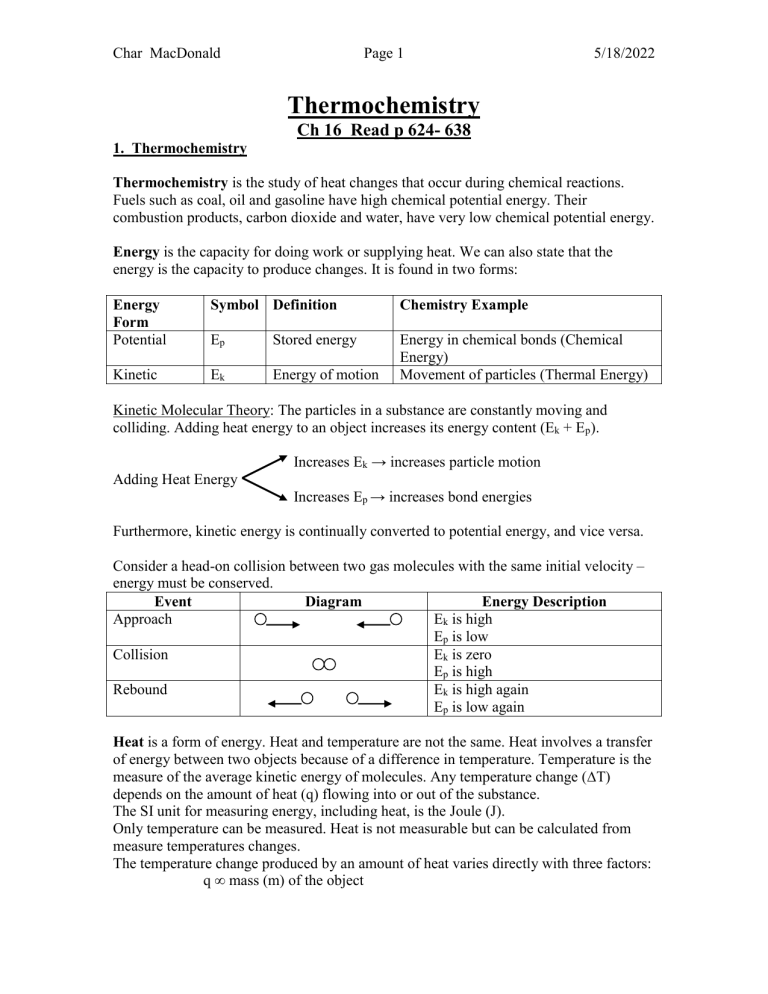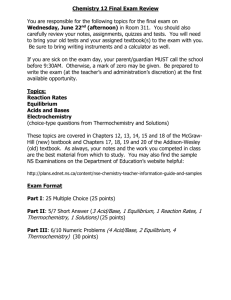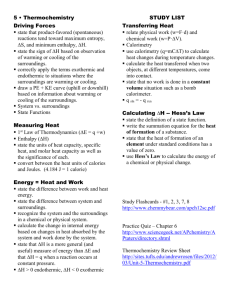
Char MacDonald Page 1 5/18/2022 Thermochemistry Ch 16 Read p 624- 638 1. Thermochemistry Thermochemistry is the study of heat changes that occur during chemical reactions. Fuels such as coal, oil and gasoline have high chemical potential energy. Their combustion products, carbon dioxide and water, have very low chemical potential energy. Energy is the capacity for doing work or supplying heat. We can also state that the energy is the capacity to produce changes. It is found in two forms: Energy Form Potential Symbol Definition Chemistry Example Ep Stored energy Kinetic Ek Energy of motion Energy in chemical bonds (Chemical Energy) Movement of particles (Thermal Energy) Kinetic Molecular Theory: The particles in a substance are constantly moving and colliding. Adding heat energy to an object increases its energy content (Ek + Ep). Increases Ek → increases particle motion Adding Heat Energy Increases Ep → increases bond energies Furthermore, kinetic energy is continually converted to potential energy, and vice versa. Consider a head-on collision between two gas molecules with the same initial velocity – energy must be conserved. Event Diagram Energy Description Approach Ek is high Ep is low Collision Ek is zero Ep is high Rebound Ek is high again Ep is low again Heat is a form of energy. Heat and temperature are not the same. Heat involves a transfer of energy between two objects because of a difference in temperature. Temperature is the measure of the average kinetic energy of molecules. Any temperature change (∆T) depends on the amount of heat (q) flowing into or out of the substance. The SI unit for measuring energy, including heat, is the Joule (J). Only temperature can be measured. Heat is not measurable but can be calculated from measure temperatures changes. The temperature change produced by an amount of heat varies directly with three factors: q ∞ mass (m) of the object Char MacDonald Page 2 5/18/2022 q ∞ specific heat (c) of the object q ∞ temperature change (ΔT) in the object Therefore, q = mcΔT (i) Specific Heat (c) o C. = heat requires to raise the temperature of 1 g of a substance by 1 = has the unit J / g · oC (ii) Some specific heat values have been tabled for you. Be careful. They depend on the physical state of the substance. (iii) ∆T = Tfinal - Tinitial If ∆T > 0, the q will become a positive number (heat is gained). If ∆T < 0, the q will become a negative number (heat is lost). Try This: Calculate the missing values. Using , q = mcΔT Substance Heat Mass Specific Initial T Exchanged (g) heat (J / Temperature (oC) o (J) g · C) (oC) Water +1530 20.0 Aluminum 14 95 +3600 20 14 Steam -1500 -25 Mercury +825 152 42.0 Final Temperature (oC) 23.2 26 48 116 It is useful in thermochemistry to define a system as the part of the universe on which we focus our attention. For example, a system might be the chemicals that will undergo reaction and the surroundings a water bath that surrounds the flask that contains the chemicals. Together, the system and surroundings constitute the universe. The changes that are of interest in thermochemistry are the flow of heat from the system to the surroundings or to the system from the surroundings. The first law of thermodynamics is that the energy of the universe remains constant. No energy is created or destroyed as a result of these heats of transfers. Char MacDonald Page 3 5/18/2022



